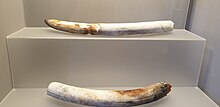Bajo de la Campana Phoenician shipwreck
The cargo also contained pine cones, double-sided wooden combs, amber nodules from the Baltic, and various raw materials such as timber and resin.
Provisions and personal items of the crew were also recovered from the wreck, such as a gaming piece, a whetstone with Phoenician graffiti, and nuts and seeds.
A survey conducted by INA in 2007 on the eastern side of the Bajo confirmed previous findings and indicated that most of the Phoenician ship wreckage remained buried beneath rocks, sediment, and seagrass.
[2][9] Due to the remains discovered, it is believed that this ship was carrying luxury items to be gifted or traded with indigenous people in exchange for commercial privileges and access to the resources in the Iberian peninsula.
[3] The presumed voyage of the ship found at the Bajo de la Campana shipwreck began towards the end of the seventh century BCE.
Additionally, many small remains were trapped between rocks at the base of the shoal and some pottery pieces were scattered around the seabed, held down by sediment.
[3] The cargo also contained raw metals, including over a ton of lead ore, 154 plano-convex ingots of tin and thirteen of copper (mostly small and circular),[5][3] along with 10,000 galena nuggets used in silver extraction.
[7] Isotopic analysis conducted on the raw materials found at the shipwreck indicates that the ship’s cargo of metals was mined from many geological sources.
[3] The ship carried a diverse range of Phoenician pottery, including amphoras, plates, pots, bowls, tripod mortars, lamos, an oil lamp, and various jugs and pitchers.
Vuillemot type R-1, produced in colonial workshops in Spain and North Africa, was distributed widely from the Atlantic coast of Morocco to Sicily.
Also found were small ceramic bottles, or unguentaria, used for perfumed oils, with examples from Archaic-period sites being imports from Phoenicia proper.
[14] Excavations have revealed several exotic objects, including an ivory knife handle, double-ended boxwood combs, decorated ostrich eggs, ivory ring stand, a pin made of antler, a stone pedestal, an alabaster jar, a pale-green stone block, a bronze object, a gaming piece, and various bronze and wooden furniture elements.
[4][10] The carved ivory knife handle, though slightly damaged, retains an elegant design and features a long slot for the blade tang and rivets.
[5]The bronze furniture elements include legs, corner fittings, and wooden pieces, likely parts of ornate chairs, stools, or beds.
[6] The cargo on this ship has provided important insights into the Phoenician's presence in Spain, specifically their trading networks and their workshops along the coast.
